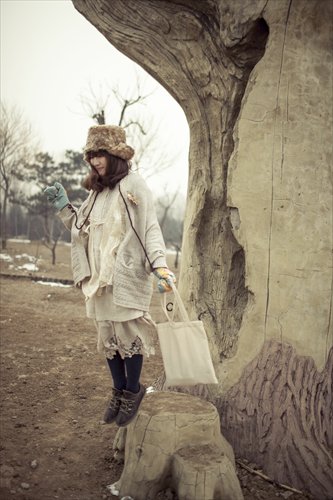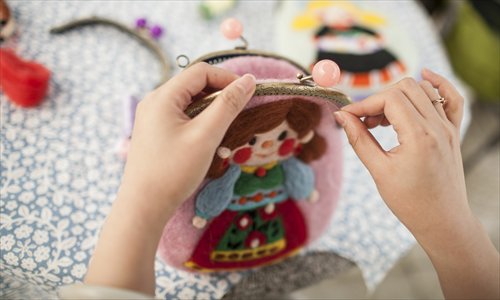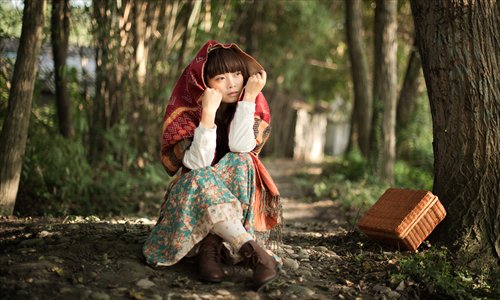The mori, the merrier

Zhao Xuan became a mori girl in 2012 when the Japanese fashion movement boomed in China. Their earthy style aims to exude a woodsy, natural aura. Photo: Li Hao/GT
Matching her long beige dress, vest and cardigan with a handmade tote bag and brooch, Zhao Xuan never fails to turn heads when she goes out. Zhao is part of Beijing's growing legion of mori girls who represent a style Japanese street fashion defined by soft, loose-fitting layers of garments often made of organic materials, such as cotton and wool, in neutral colors. The look mori ("forest" in Japanese) girls strive for is that of maidens plucked from a primeval time and place a world away from their metropolis surrounds.
Zhao, 31, defines mori fashion as "casual, comfortable and loose." "Mori girls prefer cotton and linen in brown, khaki and dark gray. Stripes, check and floral patterns are favored, with quilting lattice stitching and lace knitting both popular," she said.
Outfits are typically complemented with handmade and vintage accessories, while the most popular hairstyles include curly fringes and braids sometimes decorated with flowers.
Since emerging in Japan in 2007, the mori movement has become more than just a dress code for young women. Today it has evolved into a lifestyle that offers an earthy escape from the hustle and bustle of urban life.
Rewinding the fashion clock
Although mori girls share similar overall tastes in fashion and lifestyle, there are various subcultures within the movement. "Natural mori" girls strictly adhere to wearing only cotton and linen garments; "North European mori," which is derived from the original natural mori and inspired by Scandinavian design and style, exaggerates on the colors and patterns; "fairy tale mori" girls are often younger and favor brighter colors; and "vintage mori" girls sport ribbon weavings with traditional patterns, jacquard weavings with contrasting colors and sometimes faux fur accessories.
Searching the term "mori girl" on taobao.com, China's biggest online shopping platform, returns half a million results including clothes, fashion accessories, plants, furniture and other items.
Aside from their fashion, mori girls have specific tastes in furniture and other household items. Zakka, a Japanese term that means "many things" and refers to anything that improves a person's home, life and appearance, is another key word within mori culture.
Zhao's idea of zakka includes wooden European-style furniture, plants, dinnerware with cute patterns and creations made with her vintage sewing machine. She especially likes collecting vintage objects, such as dolls, vases, clocks and toys.
Like many mori girls, Zhao's hobbies include travel, photography, reading and watching movies. She also enjoys shopping, albeit at flea markets and fairs more than high-end malls.
"Cameras and notebooks are essential to capture beautiful moments in life and write about interesting things. Writing in a travel journal provides the perfect summary for any trip," she said.

Handmade fashion accessories, such as woollen purses, are popular with mori girls. Photo: Li Hao/GT
Moving in mori circles
A keen fan of Japanese pop culture and fashion, Zhao's conversion to mori girl occurred in 2012 when she launched her own e-commerce business selling mori clothing and accessories.
"I felt that the mori lifestyle was very comfortable and suited to my outlook on life," she said.
Zhao lists her mori role model as Tasha Tudor (1915-2008), an American illustrator and writer of children's books well-known for her love of the rustic lifestyle that inspired many young Asian women to follow in her footsteps. "Most of my friends are also mori girls. An important part of our gatherings is taking photos."
Mori girls have accounted for about 90 percent of all clients at Stone T Photography since it opened in September 2012.
Studio owner Shi Tou identifies himself as a "wenyi qingnian (artistic youth) sensationalist," a close comparison to the modern definition of "hipster." Shi is fascinated by the mori movement, which he views as having great market potential for his business.
"A photographer needs to have an in-depth understanding of the [mori] style and be familiar with its origin and subcultures. Simply taking photos of girls wearing cotton and linen clothes in the woods doesn't make good mori photography," said Shi, 32.
Life in the slow lane
Different mori girls are drawn to the movement for different reasons, but finding a "slower-paced" identity that allowed her to "better feel life" was a major motivation for Zhao.
"At the core of mori culture is its attitude towards life. It's about more than just appearances. Mori girls strive for a peaceful, natural life. They like do-it-yourself projects, have a moderate mind-set, are friendly to people, and focus on the finer details and delicacies of life," said Zhang Yan, chief editor of the mori section on Chinese fashion and beauty forum hers.com.cn.
Zhang said the mori movement came to China in 2010 and experienced a boom two years later. The mori page Zhang has overseen for the past four years now has about 200,000 active readers, she said.
Zhang credits the popularity of the mori movement in China for blossoming in the right place at the right time.
"We live in a restless world where the pace of life and work is too fast. People want to return to a peaceful, slow-paced life by breaking away from the fast urban tempo of their current existence," she said.
Shi said the main appeal of the mori movement is in its young women proudly "standing aloof from the world." "City life is too ostentatious and chaotic. It's easy for people to lose their natural instincts and desires."
Despite their vintage favoritism and disdain for designer clothes, mori girls hardly lead a cheap lifestyle. Ironically, the mori movement's anti-consumerism virtues haven't prevented numerous expensive clothing labels from capitalizing on the fashion style's boom.
"Although mori girls place great emphasis on simplicity, this doesn't mean avoiding consumption all together, which is an indispensable part of urban life," explained Zhang.
"[Anti-consumerism] can only apply to those who actually live in forests, so it's a paradox that we try to find some balance in. For example, making clothes and other items by hand on one's own can be more fun and rewarding than simply buying them from stores."

Mori girls' preference for wearing multiple layers of loose-fitting clothing in neutral colors is in stark contrast to some sexy Japanese street fashion styles.Photo: Courtesy of Stone T Photography
Less saucy sex appeal
In contrast to their mori peers, the makeup-heavy ageha ("butterfly" in Japanese) girls represent a more seductive look on streets in Tokyo and even Beijing.
Angela Song, a 20-year-old university student, is a self-confessed ageha girl who rarely leaves home without her sparkly contact lens, thick fake eyelashes, glossy nails, dyed blonde curly hair and magnificent doll-like dress.
"Mori fashion is obviously very comfortable, but it goes against my style. I like to be noticeable and avoid being perceived as boring," she said. "Many boys think ageha or Lolita (pubescent) girls are much cuter and sexier [than mori girls]."
Mori girls might try to downplay their sexuality by wearing so many layers, but Zhao insists there are men who are drawn to their simpler, more mysterious appeal.
Shi's girlfriend is a mori girl who inspired his fascination with photographing young women like her.
"Besides a preference for linen and cotton clothes, [my girlfriend] also likes handmade projects, growing plants and cooking. She doesn't aspire to lead a luxurious, material life. In this society filled with material desires, girls like this is so unique," he said.
Give yourself a mori makeover
Are you tired of dieting so you can squeeze into your tight outfits? Do fabrics of modern garments irritate your skin? Do you want to escape your current fast-paced city life and embrace a slower, simpler existence? It's time to embrace your inner mori girl.
1. Fashion: Wear loose-fitting sweaters, wide-brim hats and flat leather shoes. Choose deep earthy colors you're likely to find in the forest and don't forget to layer up.
2. Makeup: Use a red or pink blush to give your cheeks that rosy glow.
3. Vintage accessories: Jewelry should be handmade. Try and theme it around an animal, preferably one that inhabits the forest. Always use a handheld camera and pocket watch rather than a smartphone.
4. Socialize: Drink herbal tea at cafes and read fairy tales from a book, not a handheld gadget. Browse homeware stores for classic furniture, small plants and handmade ornaments.
5. Hair: Use an organic shampoo and conditioner, preferably scented with berries or wildflowers from the forest. Whether curly, frizzy or straight, keep it natural and don't be shy to accessorize with a flower or two. Shaving legs and armpits is optional.
6. Music: Listen to Celtic, folk and instrumental music. Learn the harp or bamboo flute.